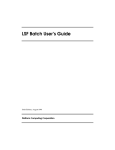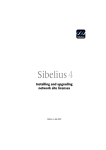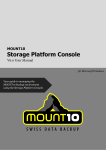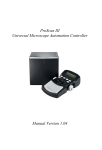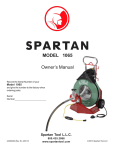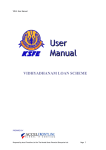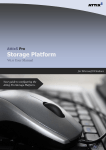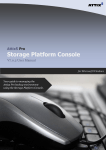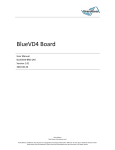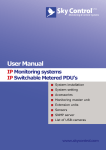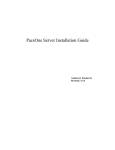Download Sibelius 6 Licence Server User Guide
Transcript
Licence Server User Guide Edition 6 April 2009 Booklet written by Daniel Spreadbury. Sibelius Licence Server copyright © 2001–2009 Avid Technology, Inc. The Sibelius Licence Server constitutes part of the Sibelius Product and is subject to the Sibelius licence agreement, supplied with Sibelius or available on request. You are not licenced to install or use the Sibelius Licence Server unless you are a registered Sibelius network version user. Contents Introduction to network site licences . . . . . . . . . . . . . . . . . . . . . . . . . . . . . . . . . . . . . . . . . . . . . . . . . . . 4 Installing and upgrading 5 Installation on Windows . . . . . . . . . . . . . . . . . . . . . . . . . . . . . . . . . . . . . . . . . . . . . . . . . . . . . . . . . . . . . . 7 Installation on Mac OS X . . . . . . . . . . . . . . . . . . . . . . . . . . . . . . . . . . . . . . . . . . . . . . . . . . . . . . . . . . . . 10 Upgrading on Windows . . . . . . . . . . . . . . . . . . . . . . . . . . . . . . . . . . . . . . . . . . . . . . . . . . . . . . . . . . . . . . 13 Upgrading on Mac OS X . . . . . . . . . . . . . . . . . . . . . . . . . . . . . . . . . . . . . . . . . . . . . . . . . . . . . . . . . . . . . 15 Installing Sibelius . . . . . . . . . . . . . . . . . . . . . . . . . . . . . . . . . . . . . . . . . . . . . . . . . . . . . . . . . . . . . . . . . . . 17 Configuring and using the Licence Server 19 Configuring the Licence Server . . . . . . . . . . . . . . . . . . . . . . . . . . . . . . . . . . . . . . . . . . . . . . . . . . . . . . . 21 Registering the Licence Server . . . . . . . . . . . . . . . . . . . . . . . . . . . . . . . . . . . . . . . . . . . . . . . . . . . . . . . . 23 Testing the Licence Server . . . . . . . . . . . . . . . . . . . . . . . . . . . . . . . . . . . . . . . . . . . . . . . . . . . . . . . . . . . 27 Access Control . . . . . . . . . . . . . . . . . . . . . . . . . . . . . . . . . . . . . . . . . . . . . . . . . . . . . . . . . . . . . . . . . . . . . 29 Setting up Classroom Control . . . . . . . . . . . . . . . . . . . . . . . . . . . . . . . . . . . . . . . . . . . . . . . . . . . . . . . . 31 Working with clients . . . . . . . . . . . . . . . . . . . . . . . . . . . . . . . . . . . . . . . . . . . . . . . . . . . . . . . . . . . . . . . . 32 Reading logs . . . . . . . . . . . . . . . . . . . . . . . . . . . . . . . . . . . . . . . . . . . . . . . . . . . . . . . . . . . . . . . . . . . . . . . 34 Maintaining the Licence Server . . . . . . . . . . . . . . . . . . . . . . . . . . . . . . . . . . . . . . . . . . . . . . . . . . . . . . . 36 Troubleshooting . . . . . . . . . . . . . . . . . . . . . . . . . . . . . . . . . . . . . . . . . . . . . . . . . . . . . . . . . . . . . . . . . . . . 38 Appendices 41 Appendix A: Starting or stopping the Licence Server . . . . . . . . . . . . . . . . . . . . . . . . . . . . . . . . . . . . . 43 Appendix B: Manually configuring the Licence Server . . . . . . . . . . . . . . . . . . . . . . . . . . . . . . . . . . . 45 Appendix C: Manually locating Licence Server logs . . . . . . . . . . . . . . . . . . . . . . . . . . . . . . . . . . . . . . 48 Appendix D: Licence Server commands . . . . . . . . . . . . . . . . . . . . . . . . . . . . . . . . . . . . . . . . . . . . . . . . 49 Appendix E: Licence Server error codes . . . . . . . . . . . . . . . . . . . . . . . . . . . . . . . . . . . . . . . . . . . . . . . . 51 Appendix F: Useful command line commands . . . . . . . . . . . . . . . . . . . . . . . . . . . . . . . . . . . . . . . . . . 52 3 Sibelius Licence Server User Guide Introduction to network site licences Two types of Sibelius site licence are available: stand-alone site licences and network site licences. You have purchased a network site licence for a fixed number of copies. Sibelius’s network version operates on a client-server model. The client is the Sibelius program itself, which is installed on the local hard drive of each of the student workstations, and the server is the separate Licence Server program, which is installed on a single designated server or workstation. The Licence Server enables the designated number of licenced client copies to run on the network simultaneously. It also lets you send messages to users of the client copies, and close copies down from the server machine. The Licence Server itself does not have a graphical user interface, because it runs in the background, listening to requests from client copies of Sibelius on the network. The server is therefore configured and managed using the graphical Licence Server Control Panel, which you can run either on the computer on which the Licence Server is installed, or from another workstation. The Licence Server and Licence Server Control Panel programs are supplied on a separate CDROM from the Sibelius program itself. Requirements The Sibelius Licence Server and the Licence Server Control Panel will run on Windows XP, Windows 2003 Server, Windows Vista 32-bit, Mac OS X 10.4 or later, Mac OS X Server 10.4 or later, or on an Apple Xserve running Mac OS X 10.4 or later. Sibelius requires a network using the TCP/IP protocol. (Your network may use other protocols in addition to TCP/IP, but TCP/IP must be present in order for the Licence Server to communicate with the client copies.) If you use a firewall on your network, ensure that port 7312 is open both for TCP/IP and UDP traffic. If you use a Novell network, note that you cannot install the Sibelius Licence Server onto a server running Novell Netware. The Licence Server can only be run on Windows or Mac OS X servers or workstations. To run Sibelius on a Novell network, you will need to install the Licence Server program on a suitable Windows or Mac OS X workstation. 4 Installing and upgrading Sibelius Licence Server User Guide 6 Installation on Windows Installation on Windows If you are upgrading your Licence Server from any earlier version of Sibelius, see Upgrading on Windows on page 13. Installing the Licence Server * Insert the Sibelius Licence Server CD-ROM, and if installation does not begin automatically, open a window onto the contents of the disc using My Computer or Windows Explorer, then double-click LicenceServerInstaller.msi to start the installation. * You will see the following window: * Click Next. * Next you will be asked if you want to install the Windows service: Unless you are intending to install the Control Panel only on this computer (because you have already installed the Licence Server itself on another machine), you should leave the Install Windows service for Licence Server option switched on, then click Next. 7 Sibelius Licence Server User Guide * Now you will be prompted to choose an installation folder: By default, the Licence Server will be installed to the folder C:\Program Files\Sibelius Software\Sibelius 6 Licence Server, but you can change this if you wish by clicking Browse. Make sure that the Administrator group of users has full read and write access to the folder you have chosen. If your chosen folder does not exist, the installer will create it for you. On RM Community Connect 3 (CC3) systems, we recommend installing the Licence Server in the RM Public folder, as this has no restrictions, ensuring that no permissions problems will be encountered. Once you have determined where the Licence Server should be installed, click Next. * You are told that the installer is ready: Click Next. * You will see a progress bar as the Licence Server and Control Panel are installed. If you have a firewall active, you may see a window appear telling you that LicenceServerV6.exe is trying to access the Internet: this is normal and happens when the Windows service is started for the first time. Choose whichever option tells your firewall that this program is safe to access the Internet. Depending on the specific firewall you are using, you may not receive a notification at this point, in which case you should now go to your firewall’s control panel and open port 7312 for both TCP and UDP traffic. * After a few moments, you will be told that installation has completed successfully. Click Close to exit the installer. 8 Installation on Windows Configuring and using the Licence Server Now see Configuring the Licence Server on page 21. Installing Sibelius on the client computers Once you have installed and configured the Licence Server, you need to install the Sibelius client application on each client machine you want to use with the Licence Server: see Installing Sibelius on page 17. Uninstalling the Licence Server If you need to uninstall the Licence Server (e.g. to upgrade it, or to install it on another computer), do so as follows: * Choose Start > Control Panel, then double-click Add/Remove Programs (Windows XP) or Programs and Features (Windows Vista). * In the list of installed programs, select Sibelius 6 Licence Server, and click Add/Remove (Windows XP) or Uninstall (Windows Vista). * Follow the on-screen prompts to uninstall the Sibelius Licence Server. Once the Licence Server has been uninstalled, the registration data is also removed, and if you subsequently reinstall the Licence Server on the same computer, you will have to re-register and reconfigure it. 9 Sibelius Licence Server User Guide Installation on Mac OS X If you are upgrading your Licence Server from any earlier version of Sibelius, see Upgrading on Mac OS X on page 15. Installing the Licence Server The Licence Server and the associated Control Panel application should be installed to the Applications folder on your Mac’s system volume, and scripts are installed in the /Library/ StartupItems folder so that the Licence Server starts automatically when your computer starts up. The provided installer will install all the files to the correct locations, and you are strongly recommended to accept the default locations. If you want to install the Licence Server to another location on your computer, you will have to manually edit the scripts in /Library/StartupItems and /Applications/Sibelius 6 Licence Server after installation. This is not something that inexperienced network administrators should attempt! To perform the standard, recommended installation: * Insert the Licence Server CD-ROM. A window should appear showing two icons: double-click Install Sibelius Licence Server to begin. * The following window will appear: Click Continue to proceed. 10 Installation on Mac OS X You are asked to select the destination volume for the software to be installed. Choose your Mac’s start-up volume, then click Continue. * Next, you are told that the installer will perform a standard installation: On Mac OS X 10.5 Leopard, you will see a button Change Install Location, which you can use to choose on which volume to install the Licence Server; however, as stated above, you are strongly recommended to install the software on your Mac’s system volume. So just click Install. * You are now prompted to provide an administrator username and password: do so, and click OK. * Next you will see a progress bar as the files are installed to your Mac’s hard disk: * After a few moments, you will be told that the installation has completed successfully. 11 Sibelius Licence Server User Guide * Click Close to exit the installation. Configuring and using the Licence Server Now see Configuring the Licence Server on page 21. Installing Sibelius on the client computers Once you have installed and configured the Licence Server, you need to install the Sibelius client application on each client machine you want to use with the Licence Server: see Installing Sibelius on page 17. Uninstalling the Licence Server To uninstall the Licence Server: * Run Terminal, which you can find in /Applications/Utilities. * In a Finder window, go to the Sibelius 6 Licence Server folder inside your Applications folder. * Drag the uninstall.sh file onto the Terminal window. * You will see /Applications/Sibelius\ 6\ Licence\ Server/uninstall.sh appear in the Terminal window: hit Return. * You will be prompted to provide your administrator password: do so and hit Return. * You will see a few messages output to the Terminal window as the Licence Server is shut down and deleted. Once the Licence Server has been uninstalled, the registration data is also removed, and if you subsequently reinstall the Licence Server on the same computer, you will have to re-register and reconfigure it. 12 Upgrading on Windows Upgrading on Windows To upgrade your network site licence from Sibelius 1.4, Sibelius 2, Sibelius 3 or Sibelius 4 or Sibelius 5 to Sibelius 6, you will need to upgrade both the Licence Server and all the client machines. Upgrading the Licence Server * Quit the Licence Server on the computer on which it is installed, referring to the appropriate booklet. * If you have the Licence Server installed as a Windows service, uninstall it: % For Sibelius 1, 2 and 3: go to the Licence Server console and type uninstall % For Sibelius 4: open a command window (on Windows XP, choose Start > Run, then type cmd and hit Return; on Windows Vista, click Start, type cmd and hit Return), navigate to the folder that contains the Licence Server and type: LicenceServerV4 –v –uninstall % For Sibelius 5.0: open a command window (on Windows XP, choose Start > Run, then type cmd and hit Return; on Windows Vista, click Start, type cmd and hit Return), navigate to the folder that contains the Licence Server and type: LicenceServerV5 –v –uninstall % For Sibelius 5.1 or later: uninstall Sibelius Licence Server via Add/Remove Programs (Windows XP) or Programs and Features (Windows Vista). This will stop and uninstall the service, and remove all the necessary files. It is very important to uninstall the service in the correct way to avoid leaving a service that can’t be removed. * Delete the folder containing the old Licence Server to avoid confusion with the later version. Upgrading the client machines To upgrade each of the client machines, use the Sibelius 6 DVD-ROM (not the Licence Server CDROM) and follow the instructions described in the Upgrading to Sibelius 6 booklet. You can install Sibelius 6 itself on each client machine using a special command that will automatically set the serial number and Licence Server address at installation time, rather than when running the client for the first time. To do this: * Insert the Sibelius 6 DVD-ROM in the client machine. When the main installation menu appears, click Exit. * Open a command window: on Windows XP, choose Start > Run, then type cmd and hit Return; on Windows Vista, click Start, type cmd and hit Return. * Type the following command: msiexec -i D:\Sibelius\SibeliusEnglishInstaller.msi SERIAL=serialno LSINFO=ip:port where you should replace: % D with the drive letter corresponding to your DVD-ROM drive % serialno with your serial number, without spaces, e.g. SCEW600123456123456 13 Sibelius Licence Server User Guide % ip:port with the IP address (or hostname) and port number of the Licence Server, e.g. 192.168.1.10:7812 * The Sibelius installer will then run without requiring any further intervention from you. When you first run Sibelius 6, the splash screen will say UNREGISTERED COPY as the program is loading (because at that point it has not yet been registered by the Licence Server over the network), and will then change to say Registered to Network User once the program is given permission to run by the Licence Server. Running multiple Licence Servers The Sibelius 6 Licence Server, Sibelius 5.1 Licence Server, the Sibelius 4 Licence Server and the revised Sibelius 3 Licence Server may be run simultaneously on the same server and installed concurrently. If you need to do this, it will be necessary to change the port number used by at least one of the licence servers. It may be simplest to change the port number used by the new Sibelius 6 Licence Server, in which case: * Temporarily stop your existing Licence Server, consulting the documentation that was supplied with that version of the Licence Server. * Install the Sibelius 6 Licence Server, following the instructions in Installation on Windows on page 7. * Change the port number used by the Sibelius 6 Licence Server, following the instructions in Changing the port used by the Licence Server on page 36. * Restart your existing Licence Server, consulting the documentation that was supplied with that version of the Licence Server. When signing on a client copy for the first time to a licence server with a different port number, the syntax for the server IP address will be, for example,192.168.1.183:8989 (where 8989 is whatever new port you have chosen). If you do not have the most up-to-date Sibelius 3 or 4 Licence Server, visit: http://www.sibelius.com/helpcenter/upgrades.html#network to download the latest version. 14 Upgrading on Mac OS X Upgrading on Mac OS X To upgrade your network site licence from Sibelius 1.4, Sibelius 2, Sibelius 3 or Sibelius 4 or Sibelius 5 to Sibelius 6, you will need to upgrade both the Licence Server and all the client machines. Upgrading the Licence Server * For Sibelius 1, 2, 3, 4 and 5.0: % Run Terminal, change to the root user (sudo bash -login), navigate to the folder that contains the Licence Server (cd /usr/local/bin) and run the script called stop_licence_server (./stop_licence_server). % If you have set the old version of the Licence Server to run on start-up, e.g. by specifying that it should run in /etc/rc.local, you should also disable this. You can disable the line in question simply by adding a # character at the start of the line. If you followed the instructions supplied with the previous version, the line probably looks like this: /usr/local/bin/start_licence_server so edit it so that it looks like this: # /usr/local/bin/start_licence_server % You should also delete the old Licence Server executable and the three associated scripts. Again, these will normally be found in /usr/local/bin. * For Sibelius 5.1 or later: % Run Terminal, which you can find in /Applications/Utilities. % Type sudo /Applications/Sibelius\ Licence\ Server/uninstall.sh and hit Return. % You will be prompted to provide your administrator password: do so and hit Return. % You will see a few messages output to the Terminal window as the Licence Server is shut down and deleted. * Install, register, configure and run the Sibelius 6 Licence Server according to the instructions in Installation on Mac OS X on page 10. Upgrading the client machines To upgrade each of the client machines, use the Sibelius 6 DVD-ROM (not the Licence Server CDROM) and follow the instructions described in the Upgrading to Sibelius 6 booklet. When you first run Sibelius 6, the splash screen will say UNREGISTERED COPY as the program is loading (because at that point it has not yet been registered by the Licence Server over the network), and will then change to say Registered to Network User once the program is given permission to run by the Licence Server. Running multiple Licence Servers The Sibelius 6 Licence Server, the Sibelius 5.1 Licence Server, the Sibelius 4 Licence Server and the revised Sibelius 3 Licence Server may be run simultaneously on the same server and installed concurrently. 15 Sibelius Licence Server User Guide If you need to do this, it will be necessary to change the port number used by at least one of the licence servers. It may be simplest to change the port number used by the new Sibelius 6 Licence Server, in which case: * Temporarily stop your existing Licence Server, consulting the documentation that was supplied with that version of the Licence Server. * Install the Sibelius 6 Licence Server, following the instructions in Installation on Mac OS X on page 10. * Change the port number used by the Sibelius 6 Licence Server, following the instructions in Changing the port used by the Licence Server on page 36. * Restart your existing Licence Server, consulting the documentation that was supplied with that version of the Licence Server. When signing on a client copy for the first time to a licence server with a different port number, the syntax for the server IP address will be, for example,192.168.1.183:8989 (where 8989 is whatever new port you have chosen). If you do not have the most up-to-date Sibelius 3 or 4 Licence Server, visit: http://www.sibelius.com/helpcenter/upgrades.html#network to download the latest version. 16 Installing Sibelius Installing Sibelius Example scores Before you install Sibelius, you should liaise with your music staff or network administrators about the best place to install Sibelius’s example scores. * On Windows, Sibelius installs the example scores into a folder called Example Scores inside the Sibelius 6 program folder, and creates a shortcut to this folder inside the My Documents folder belonging to the current user. If you want to make these files available to all users, you should manually copy the Example Scores folder to an appropriate location on the network. * On Mac, Sibelius installs the example scores into a folder called Sibelius Example Scores inside /Users/Shared/Documents, which will be accessible to all users on that client machine. Installing Sibelius on your client machines Install Sibelius on each of your client machines following the instructions in your Handbook, using the same serial number (starting SCEW, SWEW, or SCEG) that you used to install and register the Licence Server (you don’t need to register the client copies). It is essential that Sibelius be installed on the local hard disk of each client machine. It cannot be installed on a network drive or a virtual disk. You can install Sibelius on all the client computers using the same serial number; as long as all your computers are connected on the same network via TCP/IP and can thus see the machine running the Licence Server, they can share the same licence. You can install Sibelius on as many computers as you like, but it will only allow as many copies as are licenced to be run simultaneously; you could install Sibelius on 30 computers, but if you only have a licence for 10 copies, only 10 copies will be able to run simultaneously. Note that, regardless of how many copies you have bought, you will only receive one installation DVD-ROM and serial number, valid for the appropriate number of licences purchased. Running for the first time When you run each client copy of Sibelius for the first time, you will be prompted for the location of the machine running the Licence Server. You should supply this information as an IP address (e.g. 192.168.1.100) or you can specify the server name (e.g. server). You can also enter the port on which the Licence Server is running (e.g. 192.168.1.100:8989) (although there is no need to do this unless you have explicitly changed it when setting up the Licence Server – see Configuring the Licence Server on page 21). This information is stored on the client computer and does not need to be entered again. Sibelius will then contact the server in order to get permission to run. If the maximum number of licenced copies has not been exceeded, it will start up and run normally. If the maximum number of copies has been reached, a message will inform you of this and Sibelius will quit. As the networked copies of Sibelius run, they remain in contact with the server, which maintains a list of copies running. Should a client machine crash or become disconnected for some reason, the 17 Sibelius Licence Server User Guide Licence Server will remove that copy from the list. If a copy of Sibelius cannot contact the Licence Server, it will quit, allowing the user to save their work first. Note about subnet masks A subnet mask is used on a TCP/IP network to determine which IP addresses belong to the individual network, or subnet. For example, a typical network uses IP addresses in the range 192.168.1.n (where n is an integer from 0-255); in this case, the subnet mask would be 255.255.255.0, signifying that only the last digit of the IP address of each client machine on the network may be variable. The final digit of the subnet mask address varies according to the precise range of the subnet: a value of 0 allows the full range of 0-255 to be used in the IP addresses of the client machines. In some cases, particularly where a network uses dynamically-assigned IP addressing (via DHCP), the subnet mask on the machine running the Sibelius Licence Server may not be correctly configured to allow access by all client machines on the network. The symptoms of this problem are as follows: * Sibelius cannot find the Licence Server on the network, but; * it is possible to ping the server machine from the client machine and vice versa. If you experience the above problem, review the subnet mask settings on both machines. If your network uses a router to control access from one subnet to another, the router will take precedence over the subnet mask setting. Security To maintain proper security on your network, the Sibelius 6 DVD-ROM and Licence Server CDROM should only be used by the network administrator. Store them and this booklet in a secure place after use so that students cannot access them. Do not copy the DVD-ROM or CD-ROM – copying is illegal. 18 Configuring and using the Licence Server Sibelius Licence Server User Guide 20 Configuring the Licence Server Configuring the Licence Server Terminology Before we get into the details of how to configure the Licence Server, some important terms are defined here: * Server: this is the Licence Server program itself, as opposed to a service (see below). * Service: a process on your computer that runs in the background performing one or more specific tasks. Many services are started automatically when your computer runs, or when a specific user logs in. The Licence Server is intended to be run as a service, meaning that it will be started automatically when the computer is started. Licence Server states When the Sibelius Licence Server is running, it can be in one of four different states, which are normally passed through in order, as follows: * Installed. Simply running the installer achieves this state. * Running the service. The installer also automatically starts the service. * Registered. You have to provide the Licence Server with its registration information (the Sibelius serial number and Registration Number) in order to move into the final state. * Running the server. As soon as the Licence Server is registered, it becomes fully operational, and can authorize client copies of Sibelius. You can stop and restart the Licence Server at any time using the Licence Server Control Panel; when you restart it, it will return to the same state as when you stopped it. Once the Sibelius Licence Server reaches the fourth and final state (running the server), it is ready to use. Running the Licence Server Control Panel In order to see the status of the Licence Server and make changes to its configuration, you use the Licence Server Control Panel. You can run the Control Panel either on the same machine that the Licence Server is installed, or on another workstation. To run the Control Panel: * On Windows, choose Start > Control Panel, then double-click Sibelius 6 Licence Server. * On Mac, navigate to the Sibelius 6 Licence Server folder inside Applications, then double- click the Sibelius6LicenceServerControlPanel icon. 21 Sibelius Licence Server User Guide The following window will appear: As you can see, there are five pages in the Control Panel: * Server Status shows the status of the server at a glance, and allows you to perform the essential * * * * configuration tasks: locating the server; starting and stopping the service (Windows only); registering the server; starting and stopping the server; and setting the teacher’s password for Sibelius’s Classroom Control feature. Server Options allows you to set some more advanced properties of the server, including log verbosity (i.e. how detailed the logs should be), how long the client time-out should be, and what port the server should run on. You can also run some very useful diagnostics on the Licence Server from this page. Access Control determines which computers can connect to the Licence Server, both for authorizing Sibelius clients and for determining which machines can be used to run the Control Panel to configure the server. Clients shows details of the clients that are currently connected to the server, and allows you to send messages to them, or close the clients down. Log shows the Licence Server log file, useful for diagnostics. The options on each of these pages are discussed in detail in the following pages. 22 Registering the Licence Server Registering the Licence Server Connecting to the Licence Server At the top of the Server Status page of the Control Panel, you can see the IP address of the Licence Server that the Control Panel is connected to: By default, the Control Panel assumes that the Licence Server is running on the same machine, which is represented by the special IP address 127.0.0.1, on the default port (7312). You can tell whether or not the Control Panel has successfully connected to the Licence Server by reading the status message in the Server Status group at the bottom of the page. If the Control Panel has successfully connected to the Licence Server, you will see the following status message: If you see this message, skip down to Registering the Licence Server on page 25. Unable to connect? If the Control Panel is unable to connect to the Licence Server, you will see the following status message: If you see Licence Server is not responding: * Click the Find button at the top of the page. The Control Panel will then search your local network for running Licence Servers. If multiple running servers are found, you will be prompted to choose which Licence Server to connect to. If, on the other hand, you are told that No Licence Servers were found on your subnet, or if one or more servers appears, but not the one you expect to see, read on. * Check your firewall rules. Make sure that port 7312 is open for both TCP and UDP traffic, then click Find again. 23 Sibelius Licence Server User Guide * If Find reports no licence servers, click Set and the following dialog will appear: If the Licence Server is running on the same machine from which you are running the Control Panel, make sure that Server is running on this machine (localhost) is switched on. If the Licence Server is running on another machine, type the IP address of the machine. * If you still can’t connect, check that the Licence Server process is running: % On Windows, run the Services management console (on Windows XP/2003, choose Start > Run, then type services.msc and hit Return; on Windows Vista, choose Start, then type services.msc and hit Return). In the list of services, look for Sibelius Licence Server V6: check that Status is set to Started: If Status is empty, then the service is not running, and you should try starting it manually – see Appendix A: Starting or stopping the Licence Server on page 43. 24 Registering the Licence Server % On Mac, run Activity Monitor (from /Applications/Utilities), and make sure that the Show drop-down at the top of the window is set to All Processes. Type licence into the Filter edit box, and you should see the LicenceServer process listed: Don’t worry if the LicenceServer process is colored red and says (Not Responding). This is a quirk of how the Licence Server process appears in Activity Monitor; provided the CPU usage for the process is at a low level (e.g. below 10%), chances are everything is working fine. If the LicenceServer process does not appear in the list, you should try starting it manually – see Appendix A: Starting or stopping the Licence Server on page 43. * If all else fails, refer to the further troubleshooting steps in Troubleshooting on page 38. Registering the Licence Server To register the Licence Server, click Register. The following dialog appears: * Type your Sibelius serial number into the Serial number edit box. Once you have typed it in correctly, the Generate Computer Number will become enabled. * Click Generate Computer Number to generate your Computer Number. Now you should contact Sibelius registration with your serial number and Computer Number. 25 Sibelius Licence Server User Guide * When you receive your Registration Number from Sibelius registration, type it into the Registration Number edit box. * Type the number of seats in your license into the Number of copies edit box. * Once you have typed both the number of copies and the Registration Number correctly, the OK button will become enabled. * Click OK to complete the registration: after a few moments you will be told that your registration was successful. You will now see the following status messages near the bottom of the Server Status page: Congratulations! Your Licence Server is now registered and running. Notice that you are told the total number of copies in your license (in the above example, 25 clients), and how many clients are connected at the moment (in the above example, none). The next step is to test client-server communication with the Licence Server using the built-in testing feature. 26 Testing the Licence Server Testing the Licence Server Once you have registered the Licence Server, you can test client connections to the server using the Licence Server Control Panel. Choose the Server Options page: To test client connections, simply set the Number of clients to simulate, then click Run Test Now. The Licence Server Control Panel will spawn the specified number of windows (so be careful not to set too high a number!), each of which pretends to be a running client copy of Sibelius. Each window has a colored background: A green background means that the test client is running successfully. You can see a log of the communication the client has received from the server in the pane at the bottom of the test client window. 27 Sibelius Licence Server User Guide If a test client fails to connect for whatever reason, it shows a red background: Again, you can see the reason why the test client failed to connect in the pane at the bottom of the window. In the above example, the Licence Server already had the maximum number of allowed clients connected, so it refused authorisation (hence the message not enough licences). To close all the test client windows, click Close All Test Clients. If no test clients can connect If no test clients are able to connect to the Licence Server, consider the following: * Is the Licence Server running, and if so, is it correctly registered? Check the read-out under Server Status on the Status page of the control panel. * Is your firewall blocking communication between the Licence Server and the test clients? Make sure that the correct port (7312 by default) is open for both the TCP and UDP protocols. * Is the Licence Server prevented from accepting client connections from the IP address of the computer you are using to test the connection? See Access Control on page 29. If all else fails, consult Troubleshooting on page 38. 28 Access Control Access Control On the Access Control page of the Licence Server Control Panel, you can set up rules about which computers on your network can connect to the Licence Server in order to authorize client copies of Sibelius or change settings for the Licence Server itself. Clients and Managers By now you will be familiar with the term client, meaning a computer on which Sibelius is installed, and which will be connecting to the Licence Server for authorization. Clients are specified by IP addresses, or ranges of IP addresses. A manager is a computer from which it is possible to change settings for the Licence Server. As with clients, managers are specified by IP addresses. Typically, you would need somewhat permissive access control for clients (because you may have Sibelius installed on every computer in the school, for example) and less permissive access control for managers (because only, say, the network administrator and the teacher’s workstation should be able to change Licence Server settings). Allow or Block Simply put, a machine at a given IP address can connect to the Licence Server if it is set to allow, and cannot connect to the Licence Server if it is set to block. Setting up access controls By default, only the local machine’s IP address (127.0.0.1) is given access to the Licence Server as a manager, but any machine (*.*.*.*) can connect to the server as a client. This means that you typically don’t need to configure anything in order for client machines to connect to the Licence Server. 29 Sibelius Licence Server User Guide However, you may want to specify particular ranges of IP addresses for clients and managers, in which case read on. Local area networks usually use one of three specially designated ranges of IP addresses (10.0.0 – 10.255.255.255, 172.16.0.0 – 172.31.255.255 or 192.168.0.0 – 192.168.255.255). If you are not sure what range of IP addresses is used by your network, contact your network administrator before you proceed. Normally you will want to grant client access to your whole subnet. For example, if the IP addresses of all your clients are in the range 172.16.0.0 –172.16.1.255, you would type 172.16.*.* into the boxes provided, as follows: then click the Allow button next to Client, then click Apply to send your changes to the Licence Server. An asterisk (*) means that the Licence Server should accept any value in the range 0–255. You may need to block client access to a particular IP address or a range of machines, in which case enter the IP address as above, and click Block, then Apply. To grant manager access, enter the IP address as above, then click the Allow button next to Manager, then Apply. You are recommended to limit manager access to only those machines that absolutely require it. To remove a specific access control restriction, select the appropriate row in the table at the top of the page, then click Delete. If at any point you want to reset the access control settings to their defaults, click Restore Defaults. You will be asked to confirm that you want to proceed: click Yes. 30 Setting up Classroom Control Setting up Classroom Control Sibelius’s Classroom Control feature allows you to perform simple classroom management tasks directly from within Sibelius, including sending files to student workstations, getting files from student workstations, “freezing” the client copies of Sibelius so that you can attract the attention of the students in the classroom, and more. Setting the teacher password To ensure that only the teacher has access to the File > Classroom Control dialog in Sibelius. To change the password, go to the Status page of the Licence Server Control Panel, and click Change teacher’s password. The following dialog appears: Type the default password (sibelius) into the Current password field, then type your new password into the New password and Confirm password fields, and click OK. The Licence Server Control Panel will warn you if the passwords don’t match, or if the new password is the same as the current password. Make sure you keep your password secure, and try to make it difficult for students to guess. For more information, b 5.3 Classroom Control in Sibelius Reference. 31 Sibelius Licence Server User Guide Working with clients The Clients page of the Licence Server Control Panel shows real-time information about the client copies of Sibelius currently connected to the Licence Server: * Address shows the IP address from which the client is connected. It is possible for multiple * * * * clients to appear to connect from the same IP address if your Licence Server is located on the opposite side of a firewall or router from your client machines, or in other situations where your network uses Network Address Translation (NAT). Client ID is a numeric identifier given to each client machine when it first connects to the Licence Server. This identifier remains associated to that client machine as long as it is connected to the server for that session, and when the client disconnects and reconnects (e.g. because a student quits and restarts Sibelius), it will be assigned a new identifier. Similarly, when the Licence Server is restarted, the client IDs are simply reassigned from 1 again. (Client IDs are used by the Licence Server to ensure that it can tell each client apart, especially when your network employs NAT.) User name shows the username of the account currently logged in to that particular computer. Time Connected shows how long each client has been connected for, in hours, minutes and seconds. Last Polled shows when the Licence Server last polled the client and received a reply. Typically, clients will be polled every few seconds, and only when you suffer a network outage of some kind (or when the client computer crashes) will the client not be able to respond to the Licence Server’s poll message. In addition to seeing real-time information about the clients currently connected, you can perform some simple operations on the client machines, namely sending a message to one or more clients, or closing one or more clients. 32 Working with clients Sending messages to clients If you need to send a message to one or more clients, e.g. to inform them that the lesson ends in a few minutes, or that the computer lab will be closing shortly, you can select the client (by clicking) or clients (by Shift-clicking or using Ctrl+click or X-click) from the list at the top of the dialog, then click Send Message. A simple dialog appears: Type your message and click OK. Your message will appear within a few moments on the screens of each of the clients to whom you chose to send it. Closing clients To close one or more client, select the client (by clicking) or clients (by Shift-clicking or using Ctrl+click or X-click) from the list at the top of the dialog, then click Close Selected Clients. Within a few moments, each of the client machines will prompt the student to save their work, and then shut down. 33 Sibelius Licence Server User Guide Reading logs The Logs page of the Licence Server Control Panel shows the log messages generated by the Licence Server: * Time shows the timestamp at which a given event occurred. * Client Address either shows the IP address of the client machine, or if it is an informational message generated by the Licence Server itself, this will read (Status). * Message shows the text of the message itself. Some of the common messages you will see: % Adding client id: n (x of y): when a client first connects to the Licence Server, it is assigned client ID n, and you are informed that this is copy number x of the number of concurrent copies allowed, y. % Client add request version: this means that a client has asked the Licence Server for authorization. % Client alive: this means that a client has been successfully authorized. % Poll response from client id n: this is the response of the client to the Licence Server’s poll request. % Poll count -1 for id n: this means that client ID n has stopped responding to the Licence Server’s poll requests. % Removed client from list: this means that a client has closed. The buttons at the bottom of the page allow you to perform various operations on the log: * Save As: if you encounter problems with the Licence Server, it is very useful to send your log file to Sibelius technical support. Simply click Save As to save a text file suitable for attaching to an email. 34 Reading logs * Clear will empty the log. Note that this not only clears the display in the Licence Server Control * * * * Panel: it deletes the existing log altogether. (The log is also deleted each time you start the Licence Server.) Refresh forces the display of the log file to be updated. The display is automatically updated every few seconds, but if you want to force an update, you can do so. Mark inserts a marker line in the log file, which can be useful when trying to diagnose what the Licence Server is doing while it’s running. Status inserts a status report message into the log, including important bits of configuration information (including the Licence Server’s serial number, IP address and port, number of registered copies, client and manager access control lists, and so on) that can help Sibelius technical support to diagnose any problems you may encounter. Comment shows a simple dialog into which you can type a comment to be inserted in the log file. You can use this to annotate a sequence of events in the log; again, this can be very useful in helping Sibelius technical support to diagnose problems. Log verbosity You can control how detailed the Licence Server logs are by adjusting the slider on the Server Options page of the Licence Server Control Panel: While you are configuring and testing your Licence Server, you may find it helpful to drag the slider to the right to increase the verbosity. Once your Licence Server is running smoothly, you can safely drag the slider back to the left in order to make the logs more concise. 35 Sibelius Licence Server User Guide Maintaining the Licence Server There are a handful of other maintenance tasks that can be performed from the Licence Server Control Panel, described below. Changing the port used by the Licence Server The Licence Server’s default port is 7312. There is normally no need to change this, and we recommend that you leave this setting at its default. If, however, you need to change the port, click Change Port on the Server Options page of the Licence Server Control Panel. The following dialog appears: As the message in the dialog makes clear, changing the port after you have already set up your Licence Server can be very inconvenient, because you need to reconfigure each client machine to use the new port afterwards. Changing the number of copies in an existing site licence If you decide to increase the number of copies in your Sibelius network site licence, you will need to unregister your Licence Server and obtain a new Registration Number from Sibelius registration. To unregister your Licence Server, click Unregister on the Status page of the Licence Server Control Panel. You will be asked if you are sure you want to unregister the Licence Server: if you click Yes, the Licence Server will become unregistered, and it will no longer be able to authorize any client copies of Sibelius. To re-register your Licence Server with a larger number of copies, follow the procedure described in Registering the Licence Server on page 23. Unexpected exits In the unlikely event that a copy of Sibelius running on a client machine exits unexpectedly (e.g. if it crashes), or if the computer on which Sibelius is running crashes or requires a reboot, when the student runs Sibelius again, the Licence Server will attempt to identify that the same client is reconnecting, and re-authorize it immediately. If, however, the Licence Server is unable to recognize the client, the student may see the error message Sibelius cannot run because the server already has a copy registered on this address. In this situation, the student can wait for the designated time-out period, and he or she will then be able to successfully restart Sibelius. 36 Maintaining the Licence Server By default, the time-out period is three minutes, but you can change this on the Server Options page of the Licence Server Control Panel: Simply drag the slider to the right to increase the time-out period, or to the left to reduce it. 37 Sibelius Licence Server User Guide Troubleshooting Error codes For a complete list of the error codes that can be returned by the Licence Server, see Appendix E: Licence Server error codes on page 51. Error message ‘unable to bind sockets’ (Windows XP) If you get the error message Unable to bind sockets, check your firewall settings (in Start > Control Panel > Network Connections). Error 0005 Access Denied If the Licence Server service in Windows fails to start automatically, you may get an Error 0005 Access Denied when you try to start it manually. This usually means that the folder in which the Licence Server is installed has restricted access. Licence Server is apparently installed correctly but the clients cannot “see” the Licence Server * Open a command window (Windows) or Terminal window (Mac) and use ping to contact the server from the client and vice versa to establish basic connectivity. If ping is successful in both directions, network traffic is able to be routed between the two machines. If ping fails, it’s possible that another device on the network (e.g. a programmable switch) is blocking the traffic between the Licence Server and the client. Check the logs to see if you are getting an “extra slave alive” message. * Review your access settings using the Access Control page of the Licence Server Control Panel – see Access Control on page 29. * This can also be caused by your firewall. Try this trick: if you are running the Control Panel on the same machine as the Licence Server, add the server’s IP address to the list of allowed managers, then connect to the server by IP address (or use the Find button). If you are unable to connect or test the server in this way, it suggests that the firewall on your local machine is not allowing connections through on the Licence Server’s port. If you are able to test the server but other clients still can’t connect, then check the settings of any other firewalls or routers on your network. Error message ‘Could not bind the IP socket to the correct port’ If you see the error message Could not bind the IP socket to the correct port when running the Licence Server, you may be running another application on this port already. You may even be running the Licence Server already: perhaps you are running the Sibelius 3, Sibelius 4 or Sibelius 5 Licence Server at the same time as the Sibelius 6 Licence Server, or perhaps the Licence Server has crashed and the crashed process needs to be killed before it can be restarted. If you legitimately have another application using the same port, you can solve this problem changing the Licence Server’s port (see Changing the port used by the Licence Server on page 36). 38 Troubleshooting Client copies of Sibelius on Mac lose contact with the Licence Server Make sure that your server is not allowed to go to “sleep” as this will stop the Licence Server from responding. You should also ensure that your server does not install software updates automatically, as this will also stop the Licence Server from responding. Licence Server receives messages but client doesn’t “see” Licence Server This can be caused by the firewall settings in Windows XP Service Pack 2. Turn the firewall off to check this and, if this works, add an appropriate exception to the firewall rules. A clue to this problem is found when viewing the log: you will see slave alive followed by an extra slave alive message. This should not happen with the Sibelius 6 Licence Server, as it has been written specifically to allow client copies to connect through a firewall. Licence Server fails to test successfully Did you forget to include the localhost, 127.0.0.1 in your clients allowed access control list? Using the log to troubleshoot The log can be very informative when investigating a client that fails to be authorized. For example, you will see Bad serial number in the log if a client attempts to connect using a different serial number than the one in use by the Licence Server. You will see Bad version number if a copy of an older or newer version of Sibelius attempts to connect to the Licence Server, e.g. you will see Bad version number 5 if a copy of Sibelius 5 attempts to connect to the Sibelius 6 Licence Server. You will see Blocked client, no copies left if a new client attempts to connect to the Licence Server, but the Licence Server has already authorized the number of copies in your licence. 39 Sibelius Licence Server User Guide 40 Appendices Sibelius Licence Server User Guide 42 Appendix A: Starting or stopping the Licence Server Appendix A: Starting or stopping the Licence Server Normally you should use the Licence Server Control Panel to start and stop the Licence Server. But should you need to start or stop the Licence Server without using the Control Panel, you can do so as follows: Starting the Licence Server on Windows * First, open a command prompt window: % On Windows XP/2003: choose Start > Run, then type cmd and hit Return; % On Windows Vista: click Start, type cmd and hit Return. * This opens a command shell window: * Navigate to the folder where you installed the Licence Server using cd: cd \Program Files\Sibelius Software\Sibelius 6 Licence Server Make sure you type the line above exactly, with spaces in all the right places. You will be returned to the command prompt in the above directory. * Now, to install the service, type: LicenceServerV6 -install * You will see the following response from the Licence Server: * You will again be returned to a command prompt. 43 Sibelius Licence Server User Guide Stopping the Licence Server on Windows * First, open a command prompt window: % On Windows XP/2003: choose Start > Run, then type cmd and hit Return; % On Windows Vista: click Start, type cmd and hit Return. * This opens a command shell window. Navigate to the folder where you installed the Licence Server using cd: cd \Program Files\Sibelius Software\Sibelius 6 Licence Server Make sure you type the line above exactly, with spaces in all the right places. You will be returned to the command prompt in the above directory. * Now, to install the service, type: LicenceServerV6 -uninstall * You will again be returned to a command prompt. Starting the Licence Server on Mac OS X * Open a Terminal window and log in as root by typing: sudo bash -login * Type the root password when prompted, and hit Return. * Now type the following command: /sbin/SystemStarter -v start "Sibelius 6 Licence Server Service" Stopping the Licence Server on Mac OS X * Open a Terminal window and log in as root by typing: sudo bash -login * Type the root password when prompted, and hit Return. * Now type the following command: /sbin/SystemStarter -v stop "Sibelius 6 Licence Server Service" 44 Appendix B: Manually configuring the Licence Server Appendix B: Manually configuring the Licence Server Normally you should use the Licence Server Control Panel to configure the Licence Server, but should you need to do this without using the Control Panel, you can do so as follows: Checking the status of the Licence Server You can check the server’s status at any time by running the -query command from the command line. On Windows, refer to the instructions Starting the Licence Server on Windows on page 43 for how to type commands for the Licence Server. Then type: LicenceServerV6 -v -query On Mac, open a Terminal window, then type: cd "/Applications/Sibelius 6 Licence Server/" to change to the directory where the Licence Server executable is located. Now type: ./LicenceServer -v -query (Note that you must always prepend commands to the Licence Server with ./, which tells the Terminal that the command you’re running is a program.) This will elicit the following response from an unregistered Licence Server: Licence server version Version 6.0.0 - For use with Sibelius 6 only state: UNREGISTERED copies: 0/-1 serial: , up 0:01:00 Registering the Licence Server To register the Licence Server, you must first enter your serial number. Note the use of quotation marks. On Windows, type: LicenceServerV6 -setvar SERIAL "SCEW 123 456 789 123456" On Mac, type: ./LicenceServer -setvar SERIAL "SCEW 123 456 789 123456" entering your own serial number between the quotation marks. Note that the arguments are casesensitive, so you should be careful to type them correctly. The response will be: Set variable SERIAL = SCEW 123 456 789 123456 The next step is to register the Licence Server, and for this you will need the Computer Number. To get it, on Windows type: LicenceServerV6 -getvar COMPUTER_NUMBER On Mac, type: ./LicenceServer -getvar COMPUTER_NUMBER 45 Sibelius Licence Server User Guide The response will be: Got variable COMPUTER_NUMBER = C 1234 5678 1234 5678 You then need to contact Sibelius registration, quoting your serial number and Computer Number to obtain your Registration Number. You can then register as follows, once again taking care with quotation marks. On Windows, type: LicenceServerV6 -setvar REGISTRATION_NUMBER "R 8765 4321 8765 4321" On Mac, type: ./LicenceServer -setvar REGISTRATION_NUMBER "R 8765 4321 8765 4321" The response will be: Set variable REGISTRATION_NUMBER = R 8765 4321 8765 4321 If this is successful then the -query command should report the server as being in the configuring state. The response will be: Licence server version Version 6.0.0 - For use with Sibelius 6 only state: CONFIGURING copies: 0/10 serial: SCEW 123 456 789 123456, up 1:02:07 This tells you that the Licence Server is in configuring mode, 0 out of 10 copies are licenced, and it has been running for 1 hour, 2 minutes and 7 seconds. Access controls and other settings Next, set the access control lists. These are the IP addresses of the client computers that will apply to the Licence Server for authorization, and can be entered as a range using the wildcard *, e.g., 192.168.*.* will allow any client in any subnet of the 192.168 local network to “see” the Licence Server. The IP address part of the argument must be enclosed in quotation marks. Failure to use quotation marks will result in an incomplete state which will need you to type Ctrl+C (Windows) or Control-C (Mac) to exit. The arguments can be: * ALLOWED_CLIENTS * ALLOWED_MANAGERS * BLOCKED_CLIENTS * BLOCKED_MANAGERS Reminder: an argument is a qualifier that can be applied to a command (-setvar in this instance). Any previous settings will be replaced by the new information that you enter in quotation marks, so always remember to include the local machine’s address (127.0.0.1), else you will not be able to execute the -test command. So to allow localhost (127.0.0.1) and all machines on the subnet 172.24.170.* access to the Licence Server, on Windows type: LicenceServerV6 -setvar ALLOWED_CLIENTS "127.0.0.1,172.24.170.*" On Mac, type: ./LicenceServer -setvar ALLOWED_CLIENTS "127.0.0.1,172.24.170.*" 46 Appendix B: Manually configuring the Licence Server to which the response will be: Set variable ALLOWED_CLIENTS = 127.0.0.1,172.24.170.* To check your access control settings, use the -getvar command. On Windows, type: LicenceServerV6 -getvar ALLOWED_MANAGERS On Mac, type: ./LicenceServer -getvar ALLOWED_MANAGERS to which the response will be something like: Got variable ALLOWED_MANAGERS = 127.0.0.1 To check which machines are allowed as clients, on Windows type: LicenceServerV6 -getvar ALLOWED_CLIENTS On Mac, type: ./LicenceServer -getvar ALLOWED_CLIENTS to which the response will be something like: Got variable ALLOWED_CLIENTS = 127.0.0.1,172.24.170.* 47 Sibelius Licence Server User Guide Appendix C: Manually locating Licence Server logs Normally you should view the Licence Server’s logs using the Licence Server Control Panel, but should you need to do this manually, do so as follows. Logging on Windows The Licence Server creates a log file called LicenceServerV6.log, normally located in: * Windows 2003 Server: C:\Documents and Settings\Default User\Application Data\ Sibelius Software\Logs * Windows XP: C:\Documents and Settings\LocalService\Application Data\ Sibelius Software\Logs * Windows Vista: C:\Users\LocalService\AppData\Roaming\Sibelius Software\Logs The exact location depends on your computer’s settings, so it may be necessary to search for the folder. The logs are updated with every event. Logging on Mac OS X The Licence Server creates a log file in /var/log called LicenceServer.log (unless you have changed its name and location in the start_licence_server script). To see the last few entries in the log, open a Terminal window and navigate to the /var/log folder or the folder you have specified for the log file. Assuming you are using the default filename, type: tail -f LicenceServer.log To quit the tail command, type Control-C. To view the whole log, use the less command: less LicenceServer.log Quit the less command by typing q. 48 Appendix D: Licence Server commands Appendix D: Licence Server commands The following commands can be used from the command line: Set-up commands (accessible only from the local machine): -help or -h Displays the complete list of Licence Server commands -v or -vv Verbose or very verbose output -version or -V Displays the Licence Server version number Windows-specific service options -install Installs as a Windows service -uninstall Stops and uninstalls Windows service -startservice Starts the Windows service -stopservice Stops the Windows service -noservice Don’t try to start the service when run from the foreground Management commands – for communicating with a running service -localstatus Show status of running Licence Server(s) on local machine -test [server] [serial number] Simulate connection and authorization request from a client -testloop [server] [serial number] Simulate connection and authorization request from a client, and continue polling. -test50 [server] [serial number] Simulate connection and authorization request from a Sibelius client -testloop50 [server] [serial number] Simulate connection and authorization request from a Sibelius client, and continue polling. -query machine Get information on Licence Server on machine (IP address) -kick all Close all clients -kick address Close client on IP address address -kick address:port Close client with this IP address/port number -kick address server Close clients on this server -warn “message“ address[:port] Warn clients on this address/port -warn “message“ Display this warning message on all clients. Message must be in quotation marks. -dumplog filename [server] Writes the server’s log to a local filename -getvar variable [server] Get the specified variable from the server -setvar variable value [server] Set the variable to the specified value on the server -start [server] Start the server (if in configuring state). On Mac, the daemon has to be started first using the script start_licence_server, else this command has no effect. -stop [server] Stop the server (and return to configuring state). -unregister [server] Unregister the server, so that you can re-register (e.g. to change the number of copies the server can authorize). On Mac, you must run the script reload_licence_server in order for the server to recognise the new number of copies. -discover [broadcast mask] [port] Look for any servers running on the local subnet. If set, the LS_HOST environment variable is used by default. You can set this using the command set LS_HOST server. 49 Sibelius Licence Server User Guide Variables – for use with -getvar and -setvar SERIAL Serial number, required for registration (get only) COMPUTER_NUMBER Computer Number, required for registration (get only) REGISTRATION_NUMBER Registration Number, required for registration (set only) ALLOWED_CLIENTS Comma-separated list of IP addresses that are allowed to connect to the server for authorization BLOCKED_CLIENTS Comma-separated list of IP addresses that are prohibited from connecting to the server ALLOWED_MANAGERS Comma-separated list of IP addresses that are allowed to configure the server BLOCKED_MANAGERS Comma-separated list of IP addresses that are prohibited from configuring the server PORT The port on which the server is running (requires server restart) TIMEOUT How long the server should wait for a poll to be returned by a client, in seconds. VERBOSITY The verbosity level of the server. 50 Appendix E: Licence Server error codes Appendix E: Licence Server error codes Error code Internal error message Explanation 301 ERR_LS_CANT_CONNECT_TO_SERVER The service is not yet running 302 ERR_LS_AUTH_NO_MORE_COPIES No more licences left on server 303 ERR_LS_AUTH_ALREADY_RUNNING_THIS_IP A version is already running at this address 304 ERR_LS_AUTH_DENIED Can’t authoize this client 305 ERR_LS_SHUTDOWN Server has requested that we shut down 306 ERR_LS_INCORRECT_SIB_VERSION Licence Server is for a different version of Sibelius. 307 ERR_LS_OLD_LS_VERSION Using the wrong version of the Licence Server 308 ERR_LS_CLIENT_COMM_ERROR Can’t communicate with client 309 ERR_LS_INVALID_SERIAL Invalid serial number 310 ERR_LS_NO_ACCESS No access control has been set up 311 ERR_LS_SOCKET_FAIL Can’t create or bind network sockets 312 ERR_LS_SERVICE_CANT_FIND_MODULE Can’t find LicenceServerV6 executable to install as a service (Windows only) 313 ERR_LS_SERVICE_CANT_OPEN_SERVICEMAN Can’t open the service manager (Windows only) 314 ERR_LS_SERVICE_CANT_CREATE_SERVICE Can’t create the service (Windows only) 315 ERR_LS_SERVICE_CANT_START Error starting the service (Windows only) 316 ERR_LS_SERVICE_CANT_OPEN Error opening the service (Windows only) 317 ERR_LS_GENERAL_ERROR General error from the Licence Server 51 Sibelius Licence Server User Guide Appendix F: Useful command line commands Useful Mac OS X Terminal commands * chmod – used to change the attributes of a file * ls -al – lists all the files in a directory with their attributes * ps -a – lists running processes, which will include the Licence Server * ps -ax – lists all running processes, including hidden ones. * mkdir -m 775 name makes a directory called name with full read/write access for the owner and their group (typically the admin group), but prevents write access for other users. * tail -f logfilename will display the last 10 lines of the log file logfilename continually; useful for * * * * * * monitoring client messages. less logfilename will display the whole log file logfilename from beginning to end; quit by typing q. cd changes the current directory pico starts the Pico text editor (if installed) logout will log out from the current user, e.g. root. (You can also type Control-D.) ./filename will run an executable or script called filename in the current directory, provided you are using bash or a bash-compatible shell (as suggested earlier). Once unique characters have been typed, the Tab key will auto-complete the rest of the file name for you. To quit a running command, type Control-C. Useful Windows/DOS commands * cd – change directory (the old name for folder). * cd .. – moves to the next higher directory. If you repeat this enough times, you will get back to * * * * * 52 the root of the hard disk. cd \ – moves you to the root directory. cd \directoryname – takes you to the directory called directoryname. If you copied the Licence Server program to a folder named LSV6 (for example) then cd \LSV6 will get you there. dir – lists the contents of a directory. Use this to check that you are in the right directory. exit – closes a command prompt window. To quit a running command, type Ctrl+C.




















































